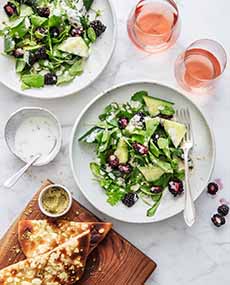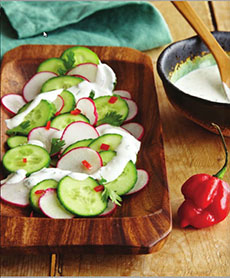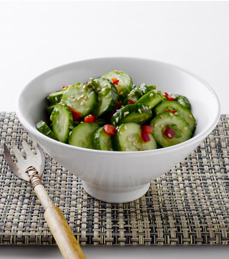TIP OF THE DAY: Low-Calorie Cucumber Salad Recipes
|
One dish that has almost dropped from sight is marinated cucumber salad. While June 13th is National Cucumber Day, pale-green cucumbers have a place on St. Patrick’s Day: as a side with a sandwich or with a main of seafood, poultry and meat—even corned beef and cabbage or a Guinness beef stew or lamb stew. So March 17th provides a good reason to whip up an easy cucumber salad. Cucumbers originated in India, but migrated to Europe as early as Ancient Rome. They were a favorite food of Emperor Tiberius. See the history of cucumbers below. Published records of cucumber salad appear in 17th century Europe. These cucumber salads were simply sliced and marinated in vinegar or lemon juice, with or without oil. Sliced onion could be added, plus fresh herbs—dill became a favorite pairing, or dill seeds. Cucumber salad has been a favorite of at least four generations of my family. (We don’t know about the family beyond that, but given that much of the family is from Russia, the odds are that it may be scores of generations.) Although it’s a great warm-weather dish, we eat cucumber salad year-round: as a side with dinner, as a bed for grilled fish, a condiment on fish sandwiches, on toast and as a filling for toasted pita, as a side with bagels and lox. Russian style cucumber salad includes sour cream mixed with lots of chopped dill, and sliced onions. And a seasoning of salt and pepper, of course. Our second favorite recipe is for Greek-style cucumber salad: Cucumbers pair with almost any regional or global cuisine. So check out the recipe ideas below, and create your own signature recipe. Did we mention: Cucumber salad is very low in calories? And a piece of food trivia: Cucumbers belong to the same botanical family as melons. You can create scores of variations to a standard cucumber salad. Cucumber peel is a good source of dietary fiber. The flesh is low in calories and high in vitamin K, anti-oxidants and potassium. Some people may have a hesitance to eat the peel, but try it. The thinner you slice the cucumbers, the easier it is to chew the peel. In fact, one way to solve the problem is to buy the long English cucumber instead of the fat, waxed supermarket variety. Many supermarkets carry them. Also called the burpless cucumber, European cucumber, hothouse cucumber and seedless cucumber, these cukes are thin skinned and almost seedless. They are easily 12″ to 14″ long, but some grow up to two feet in length (photo #6). English cucumbers were actually bred to eliminate some of the more undesirable characteristics: a tough outer skin, large seeds, in some varieties, a bitter taste, and yes, burping. The cucumber originated in India and was cultivated more than 4000 years ago. Easy to cultivate, it spread to other parts of the Pacific. By the first century B.C.E., it was traded to ancient Greece, Rome, the Middle East, and to modern-day Bulgaria and Serbia. |
|
|
|
The march of the cucumber was global. It is the fourth most widely cultivated vegetable in the world [source]. The Roman Emperor Tiberius (14 B.C.E. to 16 C.E.) ate cucumbers every day of the year. Special gardens were tended just for his vegetables. In the winter, the cucumbers were grown on bed frames or wheeled carts that were moved around to follow the sun, and brought indoors at night for warmth. (The first practical greenhouse was invented by the French botanist Charles Lucien Bonaparte during the 1800s, to grow medicinal tropical plants.) Because it is such a prolific grower (one vine grows many cukes), the vegetable was inexpensive and accessible to both the wealthy and peasants. In addition to eating, cucumbers were widely used as medicinal remedies. After the fall of Rome, cucumbers receded for a long period, resurfacing in France at the court of Charlemagne in the late 8th and 9th centuries.
|
||








